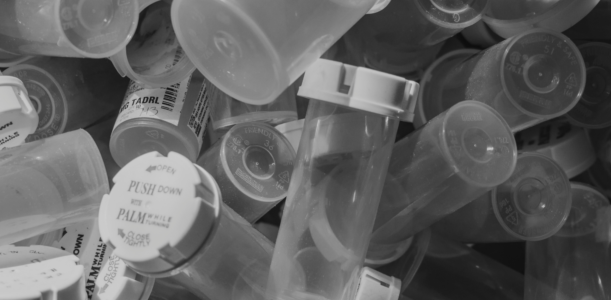Combatting the National Opioid Crisis
March 27, 2023 | Pharmaceutical Waste Disposal

Ryan spent most of his adult life dealing with stress through self-medication. Substances in his teenage years turned into Oxycodone, which led to illegal opioids and Fentanyl. He was struggling to cope with the “feeling of a life poorly lived without drugs.”
On September 27, 2019, Ryan was in an accident, crashing his truck and nearly losing his life. Ryan was operating his truck under the influence of Fentanyl.
March 13 marks the third anniversary of Ryan returning home after six months in a rehabilitation treatment program for substance addiction. (click here to read the full post)
This is just one of many stories of individuals affected by opioids. According to the CDC, 10,375 people in the United States died of drug overdoses in the 12-month period ending in January 2022. 67 percent of those deaths were attributed to Fentanyl. The opioid crisis has had an immense impact across the nation, causing immeasurable suffering. How did we get here and what resources are available to fight back against the crisis?
What are Opioids?
Opioids are a class of drugs that work as pain relievers available legally by prescription. Prescription opioids come in various forms, including tablets, capsules, syrups, solutions, and suppositories. Common legal prescription opioids are Oxycodone, Morphine and Methadone, and are prescribed by doctors to treat those with severe pain. Any opioid used by an individual not as directed or not prescribed to them is illegal. Heroin is also an illegal opioid and is not prescribed by any physician in the United States. Other Illegal opioids include Hydrocodone, Loperamide, and Fentanyl which is a synthetic opioid.
The History of Opioids
Opioids first came to market in the early 1860s as a way to treat wounded soldiers. In the 1970s, the Controlled Substances Act was passed to create regulations depending on the drug class, that divides drugs into different categories based on likelihood for potential abuse. The first wave of the Opioid Epidemic began in the mid-1990s with the rise of opioid OxyContin, as physicians were influenced to prescribe it, claiming that the risk of addiction was very low.
The second wave of the Opioid Epidemic started around 2010 with a significant increase in deaths from heroin abuse. The third wave began in 2013, with an increase in deaths related to synthetic opioids like Fentanyl. Opioids have evolved since they were introduced in the 1860s and in recent years, there has been an increase in opioid prescriptions, misuse, and related deaths.
Opioid Dependence
Substance dependence is when you need a specific drug to function, and opioid dependence can occur when opioids are taken for too long or too many are taken. One of the challenges of opioid dependence is that people develop a natural tolerance over time, meaning they need to increase dosage to get the same pain relief or to prevent withdrawal. Even at a low dose, taking an opioid for more than three months increases the risk of addiction by 15 times.
How Has the US Government Responded?
The United States is declared to be in state of public health crisis due to the Opioid Epidemic, and state and federal governments have since put plans in action to combat the emergency. President Biden increased funding to disrupt and dismantle drug trafficking operations, reduce the supply of illicit drugs like Fentanyl, and expand access to addiction care. Along with bringing awareness to the issue, the federal government is:
- Educating healthcare providers and the public about pain management, addiction, and opioid overdose and providing guidance on safe and effective pain management.
- Equipping states with resources to implement and evaluate safe prescribing practices.
- Improving access to addiction treatment and recovery services.
- Increasing access to overdose-reversing drugs, such as Naloxone.
- Tracking opioid-related trends to better understand and respond to the epidemic.
- Supporting cutting-edge research about pain management and addiction.
How can Opioid Abuse be Prevented?
Everyone in the community plays a role in ending the Opioid Epidemic. Here are some steps you can take to help prevent opioid abuse:
- Consider non-opioid options for pain management. Consider calling Goldfinch Health 1-833-453-3624 to navigate the best possible pre- and post-operations.
- Store prescription opioids in a secure place out of reach of others (including children, family, friends, and visitors).
- Participate in local drug take back events.
- Dispose of medications properly as soon as the course of treatment is done using Rx Destroyer.
- Get help. If you’re having trouble controlling your opioid use, consider calling SAMHSA’s National Helpline: 1-800-662-HELP.
Proper Opioid Disposal with Rx Destroyer
Preventing opioid dependence in your community starts with proper disposal. You should dispose of all unwanted pharmaceuticals, including opioids, in Rx Destroyer. Rx Destroyer’s patented formula begins dissolving medications on contact and is a multiple use system that can be used in facilities or at home. The Rx Destroyer All-Purpose formula is an excellent tool for disposing of opioids, ensuring that the active ingredients will not be retrievable by common means available to the general public. See our testing data here.
With regard to pharmaceutical waste disposal and other regulated activities associated with pharmaceuticals, always follow applicable federal, state, local, and tribal laws/regulations.

